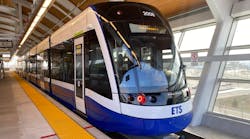City of Edmonton, Alberta, sees transit ridership levels exceed city population growth
Edmonton Transit Service (ETS) has seen ridership levels exceed the population growth of the city of Edmonton, Alberta. From January to September 2024, ETS ridership has grown by 14 percent compared to 2023.
The city notes ETS has set itself on track to move nearly 60 million riders in 2024, up from 53 million riders in 2023. The opening of the 13-kilometer (8.01-mile) Valley Line Southeast Light Rail Transit (LRT) in November 2023 has contributed to the increase by providing another option for riders to reach destinations between Mill Woods and downtown Edmonton. Nearly two million trips have been taken on Valley Line Southeast LRT between November 2023 and August 2024.
In 2023, Edmonton City Council invested in growing transit service, adding 120,000 service hours to the transit network. The city notes that while the investments help ease the pressure on transit service, the gap between current service levels and the Transit Service Standards continues to expand, as the city’s population and neighborhoods grow.
“We’ve been investing in the transit network and are proud to deliver equitable, accessible and convenient service that will continue to meet the needs of riders,” said Edmonton Transit Service Branch Manager Carrie Hotton-MacDonald. “We’re working to make it easier for people to choose transit and are excited to see this positive response. We’re thankful for our riders and the growth we’ve been experiencing.”
In April 2021, ETS launched the current bus network; year-over-year monthly ridership has increased for 42 consecutive months. In September 2024, monthly ridership exceeded six million for the first time, as ETS welcomed back students and riders from summer break. Overall, ridership has exceeded pre-COVID-19 pandemic levels by 12 percent since the beginning of the year.




